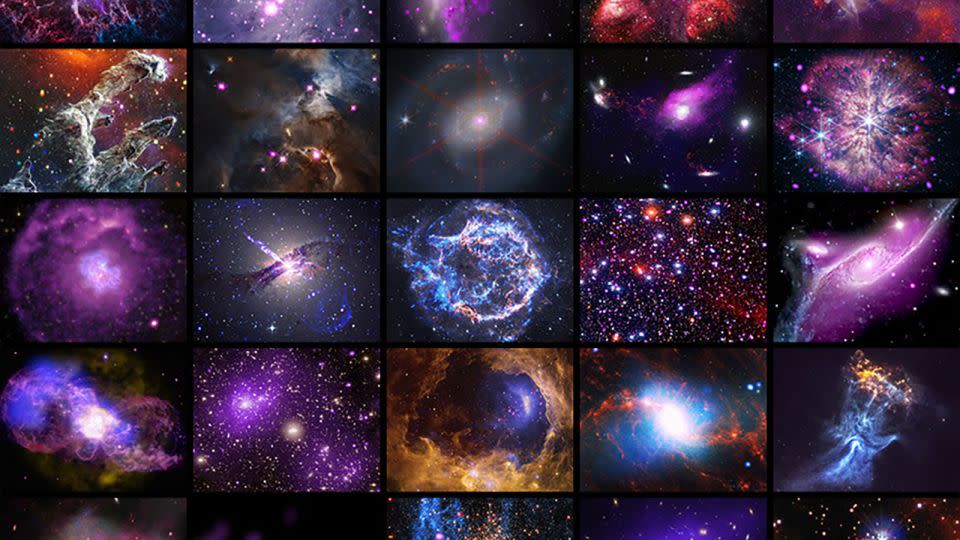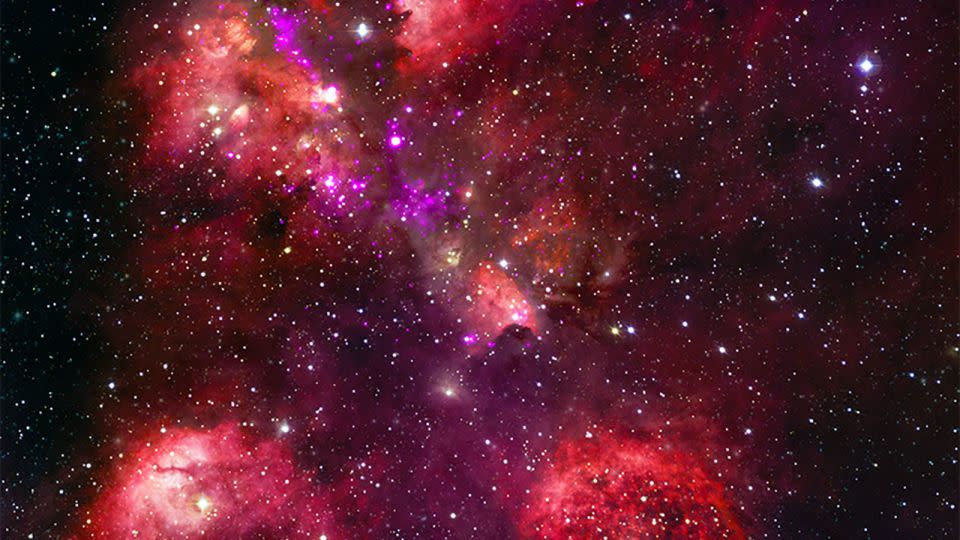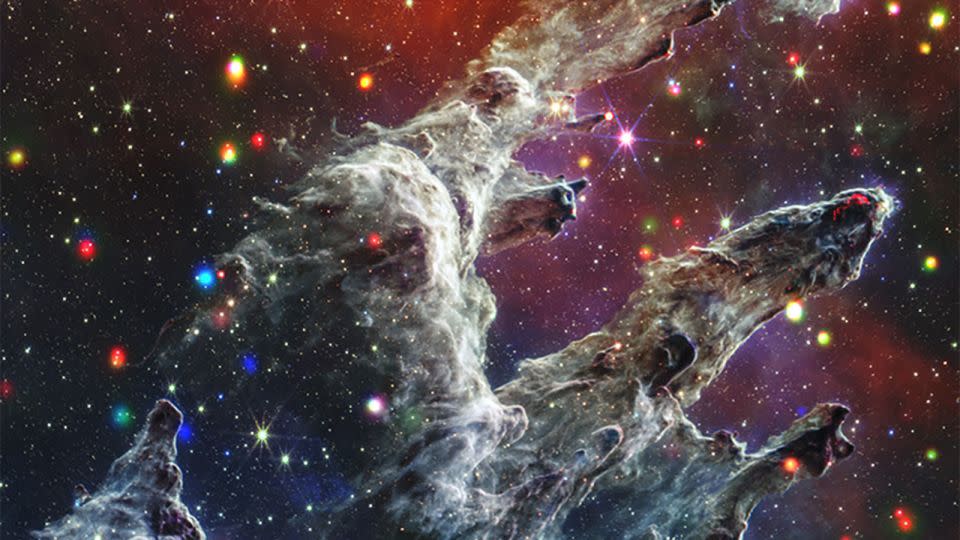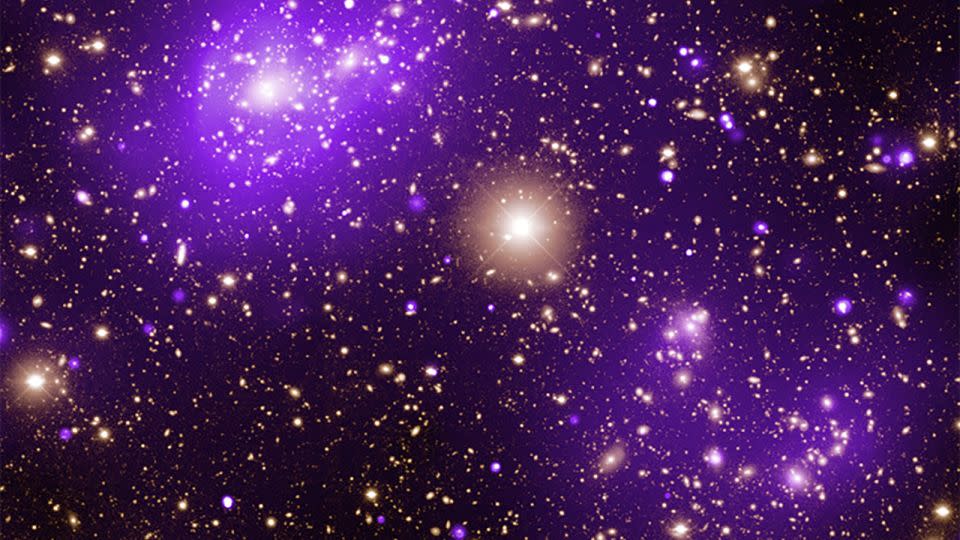Sign up for CNN’s Wonder Theory science newsletter. Explore the universe with news about fascinating discoveries, scientific developments and more.
A glowing supernova remnant, a nebula shaped like a cat’s paw and the iconic Pillars of Creation are just some of the celestial objects that shine in 25 never-before-seen images captured by NASA’s Chandra X-ray Observatory to mark the telescope’s 25th anniversary.
Chandra, named after the late Indian-American astrophysicist Subrahmanyan Chandrasekhar, was launched on July 23, 1999, aboard the space shuttle Columbia. The crew, including STS-93 commander Eileen Collins, placed the telescope in its oval orbit, sending Chandra on a path around Earth nearly one-third the distance to the moon.
“On behalf of the STS-93 crew, we are immensely proud of the Chandra X-ray Observatory and the brilliant team that built and launched this astronomical treasure,” Collins said in a statement shared in a NASA news release Monday. “Chandra’s discoveries have continued to amaze and impress us over the past 25 years.”

To date, Chandra has made nearly 25,000 observations of the universe.
The telescope observes the cosmos using X-ray light, which is invisible to the human eye. X-rays are released by some of the most energetic events and hottest objects in the universe, including exploding stars, material swirling around black holes, galactic collisions, and even exoplanets.
“For a quarter century, Chandra has been making one astonishing discovery after another,” Pat Slane, director of the Chandra X-ray Center at the Center for Astrophysics | Harvard & Smithsonian in Cambridge, Massachusetts, said in a statement. “Astronomers have used Chandra to probe mysteries we didn’t even know about when we built it — including exoplanets and dark energy.”
But the telescope’s future could be jeopardized by NASA budget cuts that threaten to end the mission prematurely by the end of this decade. And without another world-class X-ray observatory to immediately take its place, astronomical research could suffer.
Unveiling the Hidden Universe
The idea for the Chandra mission was first proposed in 1976 by astrophysicists Riccardo Giacconi and Harvey Tananbaum, who saw the importance of a large X-ray telescope and initiated its design. Along with the Hubble Space Telescope and the now-retired Spitzer Space Telescope and the Compton Gamma Ray Observatory, Chandra is one of NASA’s “Great Observatories” launched around the turn of the 20th century and designed to study the universe at multiple wavelengths of light.
The telescope has the highest quality X-ray mirrors ever built, which not only produces beautiful images but also allows for the identification of detailed structures that reveal the underlying physics of energetic cosmic objects, Slane said.
During its mission, Chandra studied the remains of exploded stars to see how matter and energy behave in space under the most extreme conditions.


Shortly after launch, the observatory turned its attention to what has become an iconic celestial object: the supernova remnant Cassiopeia A. Chandra has returned to the object again and again, providing new insights each time.
The remnant is an expanding cloud of matter and energy released when a star exploded. Over time, Chandra’s X-ray data on the remnant have allowed astronomers to locate a dense neutron star left behind by the explosion at the center of the remnant, as well as “superfluid” found within the neutron star. The fluid suggests that the original massive star may have been turned inside out when it exploded, helping astronomers better understand the violent evolution of stars.
The observatory has also seen star birth in the Cat’s Paw Nebula and the famous “Pillars of Creation,” and peered into the heart of our own Milky Way galaxy to help astronomers study the supermassive black hole at its center. And Chandra has seen vast galaxy clusters containing hundreds of thousands of glittering galaxies, as well as the superheated soup of gas around the galaxies that is visible only in X-ray light.


“Before Chandra, we knew that there was a kind of diffuse haze of X-rays coming from all directions in the sky. With Chandra, we now know that this isn’t a haze at all; it’s a huge collection of distant black holes whose emissions merge in fuzzier telescopes,” Slane said.
“There are hundreds of examples like this, where Chandra’s sensitivity has led to new discoveries or confirmed existing theories,” he added. “The legacy is not one specific discovery, it is the unique contributions to studies of things as close as planets in our solar system to supermassive black holes near the edge of time.”
With more than 10,000 scientific papers written based on Chandra data, the telescope is one of NASA’s most productive astrophysics missions.
An uncertain future
NASA’s budget is not sufficient to support all current programs while also launching new projects for the future. Therefore, some existing missions, such as Chandra, will be cut, Slane said.
“On Chandra’s behalf, the cuts would fall somewhere between drastically reducing the observatory’s scientific productivity and support for the user community, or closing the observatory,” he said. “NASA sincerely does not want to do the latter, and the community — and Congress — have been vocal about not cutting funding for a NASA Great Observatory that is still healthy and producing spectacular science, and for which there is no replacement in sight. NASA is now working to consider the overall budget situation and provide final guidance for Chandra.”
Members of the astronomical community have started a grassroots campaign called Save Chandra to raise awareness and gather support for the telescope’s future.
NASA’s budget allotment for Chandra will gradually decrease over the next few years, based on the agency’s budget request released in March. While the telescope received $68.3 million in 2023, Chandra would receive just $41.1 million for operations beginning in fiscal year 2025. Chandra’s budget allotment will then drop to $26.6 million per year beginning in fiscal year 2026 and continuing through fiscal year 2028, before dropping to just $5.2 million in fiscal year 2029, effectively ending the mission.


Despite 25 years in space, Chandra remains in good health, with virtually all of the spacecraft’s systems functioning well, Slane said. When problems have arisen, such as trying to keep the telescope at its cool, optimal operating temperature, the Chandra team has found creative solutions that haven’t reduced the telescope’s efficiency, Slane said. And there’s no concern that the telescope will run out of fuel.
While there are follow-on telescope concepts in mind that could take Chandra’s place, such as the Lynx X-ray Observatory, with better imaging capabilities, development of these tools has not been selected as a top priority. Thus, there is no immediate X-ray observatory to take over when the Chandra mission ends at the end of the decade.
Chandra plays a key role not only as an X-ray telescope, but also in providing data that accompany observations from other telescopes. Combined, all these wavelengths of light provide a more complete picture that astronomers can use to solve the enduring mysteries of the universe. What’s more, the loss of the telescope would have implications for the next generation of X-ray astronomers whose research Chandra supports.
“The loss of Chandra would be devastating not only to X-ray astronomy at this time, but to most of astronomy,” Slane said. “Its exploitation over the next decade — in addition to continuing to produce world-class science — would provide a framework within which NASA could plan for a natural continuation and growth of the U.S. X-ray astronomy program.”
For more CNN news and newsletters, create an account at CNN.com